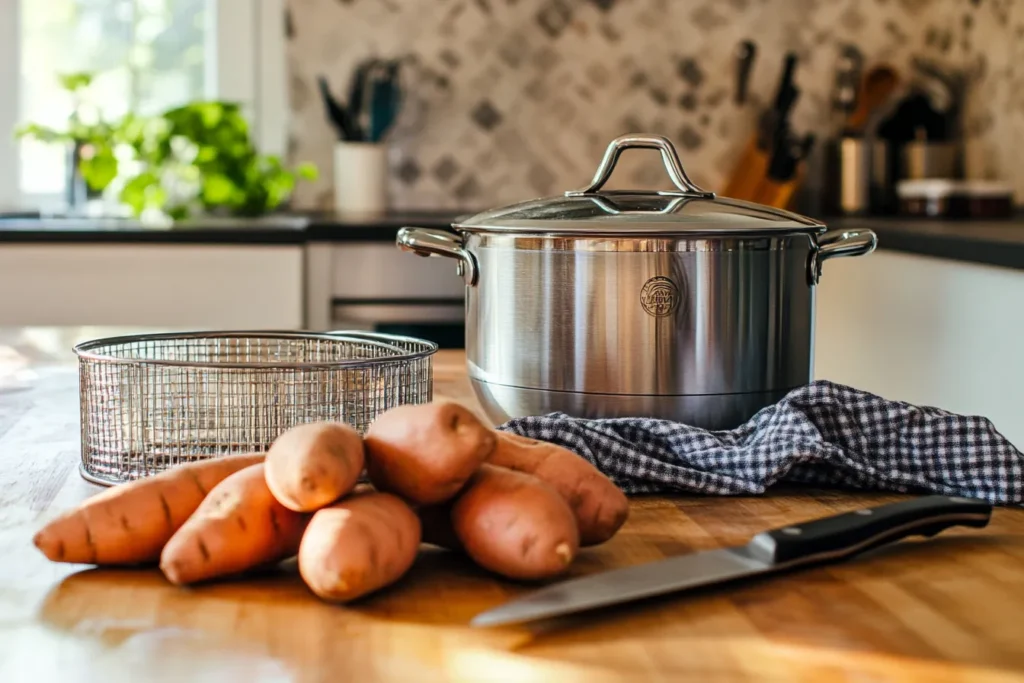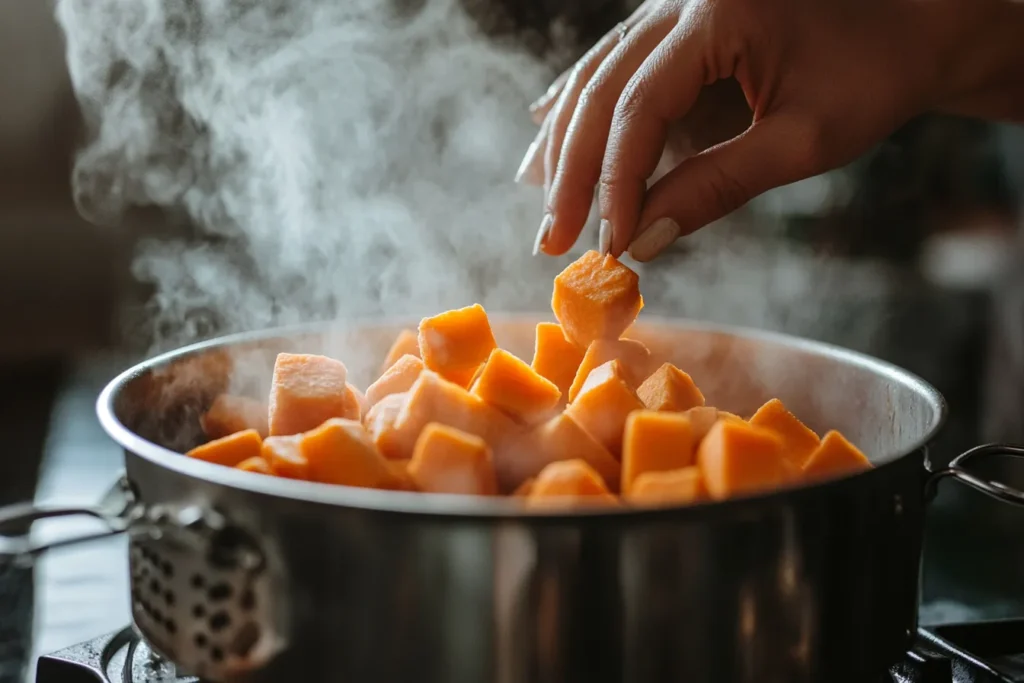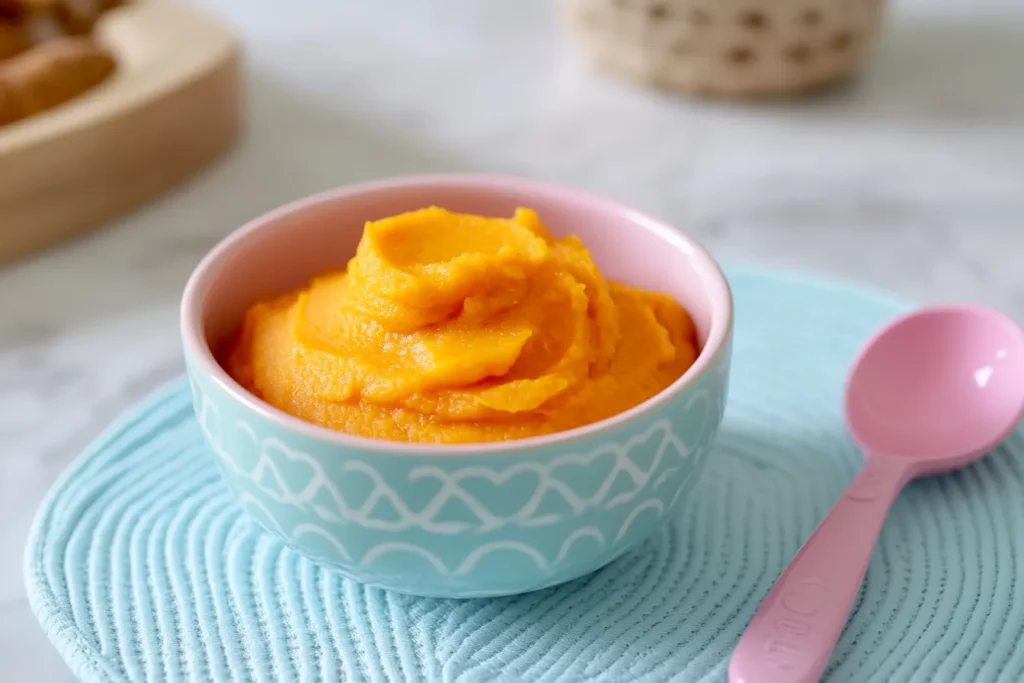Introduction
Sweet potatoes have soared in popularity in kitchens around the globe. Their natural sweetness, incredible versatility, and impressive health benefits make them a favorite among fitness lovers, foodies, and busy parents alike. Whether you’re prepping a nourishing weeknight meal, making a baby food puree, or enhancing your salad bowl, knowing how to steam sweet potatoes the right way is a kitchen skill worth mastering.
Why steaming? Unlike boiling, which can leach nutrients into the water, or roasting, which may dry them out, steaming helps preserve sweet potatoes’ moisture, nutrients, and flavor. It’s also fast, clean, and doesn’t require any oil, making it perfect for health-conscious eaters..One Pan Butternut Squash and Chickpea Casserole
In this guide, we’ll walk you through how to steam sweet potatoes step-by-step, share chef-level tips for perfect texture, and explore serving ideas that go beyond just tossing them on a plate. Whether you have a traditional steamer, an Instant Pot, or even just a metal colander and a pot, we’ve got you covered.
Ready to steam sweet potatoes like a pro? Let’s get started.
Why Steaming Sweet Potatoes is a Smart Choice
Steaming is more than just a healthy cooking technique—it’s also one of the easiest and most effective ways to cook sweet potatoes without compromising on taste or nutrition. If you’ve ever wondered whether you’re making the healthiest choice when preparing this beloved root veggie, let’s dive into why steaming sweet potatoes is one of the smartest decisions you can make.
Nutritional Benefits of Steamed Sweet Potatoes
Sweet potatoes are naturally rich in essential nutrients, and steaming helps preserve them better than other cooking methods. Unlike boiling, which can wash away vitamins like C and some B vitamins, steaming uses vaporized heat, which gently cooks the sweet potatoes while locking in key nutrients.
Here are some top health benefits of steamed sweet potatoes:
- Rich in Beta-Carotene: The vibrant orange color of sweet potatoes comes from beta-carotene, a powerful antioxidant that converts to vitamin A in the body. Vitamin A supports eye health, immunity, and cell growth.
- High in Fiber: Sweet potatoes are an excellent source of dietary fiber, which supports digestive health and keeps you fuller for longer.
- Packed with Potassium and Magnesium: These minerals are essential for heart health, nerve function, and muscle strength.
- Low Glycemic Index When Steamed: Steaming has been shown to maintain the low glycemic index of sweet potatoes better than baking or frying, making them a better option for people watching their blood sugar levels..High Protein Low Calorie Pasta Salad
✅ Tip: To get the most beta-carotene, serve your steamed sweet potatoes with a tiny bit of healthy fat (like olive oil or avocado), which improves nutrient absorption.
For more on the nutritional benefits of sweet potatoes, check out this detailed article from Healthline.
Steaming vs. Boiling vs. Roasting: Which Is Best?
When it comes to preparing sweet potatoes, the cooking method can drastically change the texture, flavor, and nutritional profile. So how does steaming compare?
| Cooking Method | Texture | Nutrition Retention | Cooking Time | Flavor Profile |
|---|---|---|---|---|
| Steaming | Moist and soft | Excellent | 15-20 mins | Mild and clean |
| Boiling | Sometimes mushy | Moderate to low | 15-20 mins | Slightly watered-down |
| Roasting | Crisp outside | Good (with skin) | 30-45 mins | Sweet and caramelized |
- Boiling: Sweet potatoes are submerged in water, which can cause water-soluble vitamins like vitamin C to leach out. It also dilutes the natural sweetness.
- Roasting: While roasting brings out the natural sugars and adds a caramelized flavor, it requires more time and oil, and may lead to a drier result.
- Steaming: This method stands out for preserving nutrients, maintaining moisture, and offering a consistent texture. It’s also faster and doesn’t require any added fats.
Steaming is particularly recommended for meal prep and baby food because of its gentle cooking method and nutrient preservation.
For more information on why steaming is such a healthy option, explore how to steam vegetables properly via Harvard’s Nutrition Source.

How to Steam Sweet Potatoes Step by Step
Whether you’re using a steamer basket, an Instant Pot, or a makeshift setup with a pot and colander, steaming sweet potatoes is surprisingly easy. With the right preparation, tools, and timing, you’ll get perfectly tender and flavorful results every single time.
Let’s break it down step-by-step:
What You’ll Need (Tools & Ingredients)
Before you start, gather the essentials. Here’s what you’ll need to steam sweet potatoes:
Tools:
- A steamer basket or metal colander
- A pot with a lid or steamer pot
- A knife and cutting board
- Tongs or a fork for testing doneness
Optional:
- Instant Pot with steam rack or trivet
- Silicone steamer basket for non-stick steaming
Ingredients:
- 2–3 medium sweet potatoes
- Filtered water (about 2 cups, depending on pot size)
- Optional flavorings: rosemary sprigs, garlic cloves, lemon slices (place under the basket to infuse steam)
✅ Pro Tip: Choose sweet potatoes that are firm, smooth, and free from soft spots or blemishes for the best results.
Step 1: Clean and Peel (or Not)
Start by rinsing the sweet potatoes under cold water to remove dirt. You can peel them using a vegetable peeler, but this is optional—the skin contains extra fiber and nutrients, so feel free to leave it on if you prefer.
If you’re cooking for babies or want a super smooth mash, peeling is recommended.
Step 2: Cut for Faster Cooking
Cutting your sweet potatoes into evenly sized pieces ensures they cook evenly. Here are three options:
- Rounds (½ inch thick) – Ideal for meal prep and salads
- Cubes (1-inch pieces) – Great for baby food or blending
- Halves or whole – Best for stuffing or serving as a main
Smaller pieces = faster steaming. Whole sweet potatoes take much longer and may steam unevenly.
Step 3: Setup Your Steaming Station
Place your steamer basket or metal colander inside a pot. Make sure the bottom of the basket doesn’t touch the water. Add about 2 inches of water—just enough to generate steam but not so much that the potatoes are submerged.
Cover the pot with a tight-fitting lid to trap the steam.
Instant Pot Method: Place the trivet inside, add 1 cup of water, and layer the sweet potatoes on top. Seal the lid and use the “Steam” function for 8–12 minutes, depending on the size of your cuts.
Step 4: Steaming Time and Temperature
Turn on the stove and bring the water to a boil. Once boiling, reduce the heat to medium-low and let the sweet potatoes steam.
General steaming times (on stovetop):
| Cut Size | Time (approx.) |
|---|---|
| 1-inch cubes | 10–12 minutes |
| ½-inch rounds | 8–10 minutes |
| Whole potatoes | 30–45 minutes |
Check the water level halfway through if steaming for more than 20 minutes—never let the pot dry out.
Step 5: Testing Doneness the Right Way
The best way to test doneness is by using a fork or knife. It should easily pierce through the thickest part of the potato without resistance. The flesh should be tender, not mushy.
If you’re making mashed sweet potatoes, steam until very soft. For chunks in salads, stop while they still hold their shape.
Pro Tip: Let them sit uncovered for 2–3 minutes after steaming to release extra moisture and avoid sogginess.
Need to store your steamed sweet potatoes? Visit the USDA’s guide on proper storage methods for cooked food for safe practices.

Tips for Perfectly Steamed Sweet Potatoes Every Time
Even though steaming is simple, there are a few key tricks that can take your results from good to outstanding. Follow these tried-and-true tips to get consistent, flavorful, and nutrient-rich steamed sweet potatoes every time.
Best Practices to Avoid Mushiness
Sweet potatoes are naturally soft when cooked, but oversteaming can make them too mushy or even waterlogged. To avoid this:
- Use a timer: Don’t guess. Follow recommended steam times based on size.
- Cut evenly: Uneven cuts cook at different speeds, leading to inconsistent texture.
- Use a lid with a tight seal: This keeps the steam trapped and cooking consistent.
- Don’t overcrowd: Give your sweet potato pieces space in the steamer basket to allow even airflow.
If you want sweet potatoes that hold their shape—for salads or meal prep—undercook slightly and let them finish cooking off the steam after removing the lid.
How to Infuse Flavor While Steaming
One of the lesser-known benefits of steaming is that you can add subtle flavor to your sweet potatoes without oil, butter, or spices directly on them. Here’s how:
- Herbs & Aromatics: Add rosemary, thyme, garlic, or ginger slices to the water.
- Citrus: Try lemon or orange slices under the steaming basket for a fresh aroma.
- Cinnamon sticks or star anise: These spices add a sweet, warming note without overpowering the dish.
Alternatively, toss your sweet potatoes in olive oil, sea salt, and spices after steaming for a clean and tasty finish.
Bonus Tip: If you’re preparing sweet potatoes for baby food, leave out added flavors and seasonings—just steam and blend.
Serving Suggestions and Recipe Ideas
Once you’ve mastered how to steam sweet potatoes, the next step is figuring out how to enjoy them! Sweet potatoes are one of the most versatile ingredients you can have in your kitchen. From savory sides to sweet dishes, they fit into nearly any meal plan.
As a Side Dish
Steamed sweet potatoes make a fantastic healthy side dish for breakfast, lunch, or dinner.
Try these ideas:
- Toss with olive oil, smoked paprika, and sea salt
- Mash with a little butter and garlic for a creamy texture
- Serve plain with a drizzle of tahini or nut butter
They’re a great side for grilled meats, tofu, or roasted vegetables.
In Salads, Bowls, and Smoothies
Diced steamed sweet potatoes can be chilled and used cold in:
- Salads: Add cubes to a quinoa salad or spinach-based bowl
- Power bowls: Pair with avocado, chickpeas, and greens
- Smoothies: Blend with banana, almond milk, and cinnamon for a creamy treat
Steaming keeps the flavor clean and smooth, ideal for recipes where a roasted flavor isn’t desired.
For Baby Food or Meal Prep
Steamed sweet potatoes are often a baby’s first food—and for good reason. They’re soft, sweet, and packed with nutrients. Just steam, blend with a little water or breast milk, and serve.
For adults, steamed sweet potatoes are perfect for:
- Weekly meal prep: Portion into containers with grains and greens
- Freezing: Store in portions for quick reheat-and-eat meals
- Snacking: Steam rounds or sticks and keep in the fridge for an easy grab-and-go snack
Bonus: They reheat beautifully in the microwave without drying out!

Common Mistakes When Steaming Sweet Potatoes
Even though steaming is one of the easiest cooking methods, a few small missteps can make a big difference in texture, flavor, and even nutrition. Let’s go over some of the most common mistakes people make when learning how to steam sweet potatoes—and how to avoid them.
Overcooking or Undercooking
Sweet potatoes that are undercooked will be hard and starchy, while overcooked ones will become mushy and soggy.
Avoid this by:
- Setting a timer based on the size of your cuts.
- Testing for doneness with a fork at the lower end of the cooking range.
- Letting them rest off heat for 2–3 minutes to finish cooking through.
Pro Tip: Cut into one piece and check the center—if it’s still firm, give it another 1–2 minutes.
Using Too Much or Too Little Water
Steaming requires just the right amount of water—not too much, not too little.
- Too much water: If the water touches the bottom of your sweet potatoes, they’ll boil instead of steam.
- Too little water: The pot can dry out and burn, ruining the sweet potatoes and the cookware.
Always check your water level before starting and halfway through if you’re steaming for longer than 20 minutes.
Not Cutting Evenly
Inconsistent cutting leads to uneven cooking. Some pieces may be mushy while others stay undercooked.
Fix this by:
- Using a sharp knife and cutting all your pieces to a similar thickness.
- Laying them out in a single layer in the basket to prevent crowding.
Even cuts = even cooking = perfect steamed sweet potatoes.

FAQs
Here are the most frequently asked questions about steaming sweet potatoes, answered clearly to help you cook with confidence.
Can I steam sweet potatoes with the skin on?
Yes! The skin is rich in fiber and nutrients. Just make sure to wash thoroughly to remove any dirt or residue. Steaming with the skin on also helps hold the shape if you’re cutting them into cubes or rounds.
After steaming, the skin can be easily removed if you prefer.
How long does it take to steam sweet potatoes?
It depends on the size:
- Cubes (1-inch): 10–12 minutes
- Rounds (½ inch): 8–10 minutes
- Whole sweet potatoes: 30–45 minutes
Use a fork or knife to check doneness—if it slides in easily, they’re ready!
What’s the best sweet potato for steaming?
Orange-fleshed sweet potatoes, such as the Beauregard or Garnet varieties, are ideal for steaming. They become soft, slightly sweet, and moist—perfect for mashing, salads, or baby food.
Japanese or white-fleshed varieties can also be steamed but tend to be drier.
Can you steam sweet potatoes in a microwave?
Yes, you can! Place cubed or whole sweet potatoes in a microwave-safe bowl with a few tablespoons of water. Cover with a microwave-safe lid or plastic wrap (poke a small hole), then microwave on high:
- Cubes: 4–6 minutes
- Whole: 8–10 minutes, turning halfway
Let sit for 1 minute before opening to release steam safely.
Are steamed sweet potatoes good for weight loss?
Absolutely. They’re high in fiber, low in fat, and naturally sweet, making them a filling and nutritious option for those trying to lose weight. Just avoid adding too much butter, sugar, or heavy toppings.
Bonus: The slow-digesting carbs help manage appetite and blood sugar levels.
How do you store steamed sweet potatoes?
Let them cool completely, then store in an airtight container in the refrigerator for up to 5 days. You can also freeze them for up to 3 months.
To reheat, steam again for 2–3 minutes or microwave until hot. For more details, follow USDA’s safe food storage guidelines.
Conclusion
Steaming sweet potatoes is one of the easiest, healthiest, and most versatile ways to prepare this naturally sweet and nutrient-packed vegetable. Whether you’re cooking for a quick weeknight dinner, prepping baby food, or building healthy meal prep bowls, learning how to steam sweet potatoes the right way opens up endless possibilities in your kitchen.
With minimal equipment, short cooking time, and no need for oil or added fats, steaming helps retain maximum nutrients while giving you a perfect, tender texture every time. By following the step-by-step instructions, avoiding common mistakes, and experimenting with new ways to serve your sweet potatoes, you can make this humble root veggie the star of any meal.
So the next time you’re at the store, grab a few sweet potatoes—your steamer (or makeshift steaming setup) is all you need to turn them into something delicious, healthy, and deeply satisfying.
Happy steaming!

Name: How to Steam Sweet Potatoes
Ingredients
Equipment
Method
- Instructions:
- Rinse and scrub sweet potatoes well. Peel if desired.
- Cut into ½-inch rounds, 1-inch cubes, or halves (for faster cooking, use smaller cuts).
- Add 2 inches of water to a pot and place steamer basket inside, ensuring water doesn’t touch the basket.
- Layer sweet potatoes evenly in the steamer basket. Cover with a lid.
- Bring water to a boil, then reduce heat to medium and steam.
- Cubes: 10–12 minutes
- Rounds: 8–10 minutes
- Whole: 30–45 minutes
- Test doneness with a fork. Sweet potatoes should be tender and easy to pierce.
- Remove from heat and let rest uncovered for 2–3 minutes before serving or storing.
